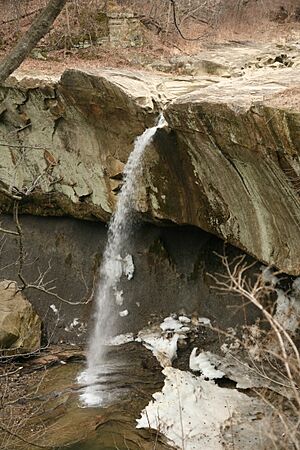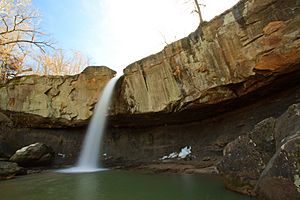Williamsport Falls facts for kids
Quick facts for kids Williamsport Falls |
|
|---|---|

The falls in March 2009
|
|
| Lua error in Module:Infobox_mapframe at line 185: attempt to index field 'wikibase' (a nil value). | |
| Location | Warren County, Indiana |
| Coordinates | 40°17′10″N 87°17′33″W / 40.286140°N 87.292630°W |
| Type | plunge |
| Total height | 90 feet (27 m) |
Williamsport Falls is a beautiful waterfall located right in the middle of Williamsport, a town in Warren County, Indiana. Standing at about 90 feet (27 meters) tall, it is the second highest waterfall in Indiana! Imagine a waterfall almost as tall as a 9-story building.
Discovering Williamsport Falls
Williamsport Falls is a unique natural wonder. It's special because it's one of the few waterfalls you can find right inside a town. Most waterfalls are in forests or parks, but this one is easy to visit in Williamsport.
How the Falls Were Formed
The waterfall was created by Fall Creek. This creek flows through Williamsport, separating the older part of town from the newer areas. At one point, the creek flows over a large ledge made of sandstone. Over many years, pieces of this sandstone ledge have broken off. This is why the waterfall's exact height has changed a little over time.
Below the falls, people used to dig up sandstone. This stone was then used to build the strong foundations for many buildings in the local area. It's cool to think that the very ground around the falls helped build the town!
Why the Water Flow Changes
Long ago, in the 1800s, there was so much water flowing over Williamsport Falls that it powered a mill! A mill uses water to turn big wheels and grind things like grain. However, the amount of water flowing over the falls isn't always the same today. Sometimes, the falls are very quiet, with only a small trickle of water.
This change happens because of how the land around the creek is used. Many forests and grassy areas have been turned into farms. Farmers often use machines and need water for their crops. So, some of the natural water flow is now used for irrigation. This means less water makes it to the falls, especially during dry times. People have looked into ways to make the water flow steady again, but it would be very expensive.


